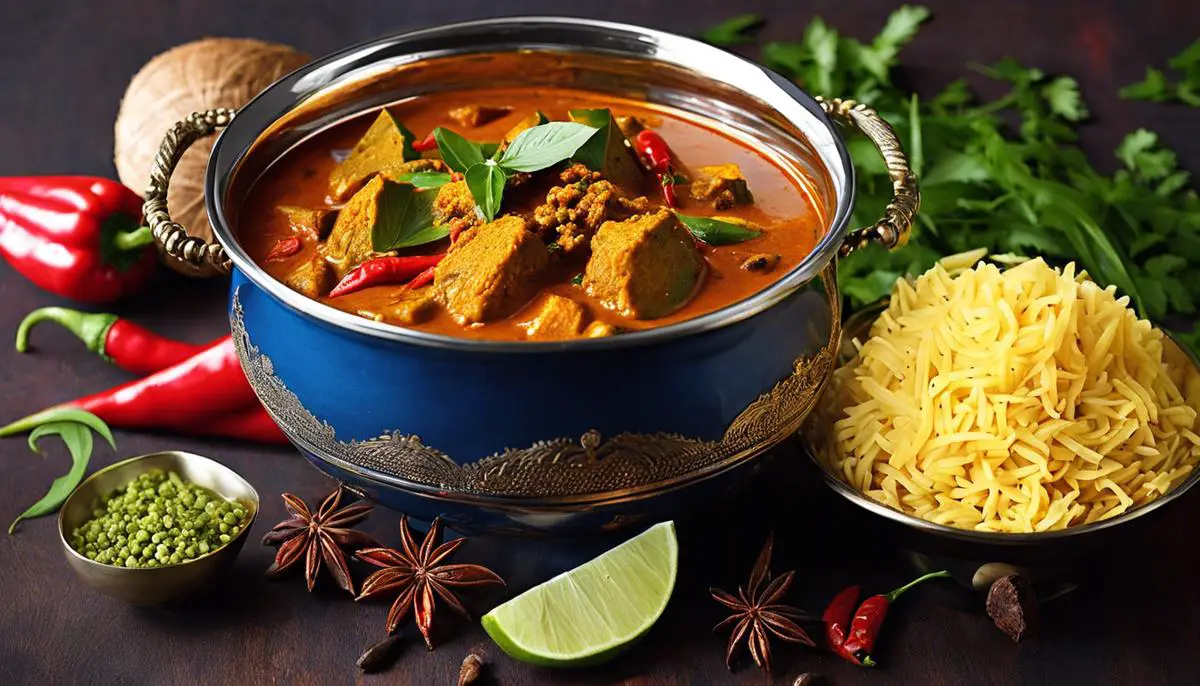
Immersing oneself in the culinary traditions of Karaikudi is not just about exploring exotic flavors, it’s about discovering a rich tapestry of spices and techniques that are the hallmarks of this vibrant cuisine. The journey begins at the very heart of its renowned curry, a tantalizing combination of textures, and a symphony of spices that sing of southern India’s gastronomic heritage. As we delve into preparing the curry base, we’ll unlock the secrets of age-old spice blends, learning the art of toasting and grinding to create the foundation of flavor that sets Karaikudi curry apart. Navigating through bustling markets or your local grocer, we’ll select the perfect medley of vegetables, each adding their unique color, taste, and texture, to complement and contrast the robust curry base. With every chop, slice, and dice, we prepare to embark on a culinary adventure that promises to captivate the palate and nourish the soul.
Preparing the Curry Base
Unlocking the Vibrant Flavors of Karaikudi: Crafting the Ultimate Curry Base
When it comes to the artistry of Indian cuisine, the magic lies in its aromas, the complexity of its spices, and the warmth it brings to the table. For the true food enthusiast, Indian curries are not just meals; they are an exploration of culture with every spoonful. Tucked away in the heart of Tamil Nadu, Karaikudi, a region famous for Chettinad cuisine, offers a culinary treasure that can transform standard fare into an exotic indulgence: the quintessential Karaikudi curry base.
This particular curry base is a symphony of flavors that can only be achieved through the meticulous balance of roasted spices, the sweetness of onions, and the richness of tomatoes. Let’s embark on a culinary journey to create this flavor-packed foundation.
Firstly, source the freshest ingredients you can lay your hands on – because, in the orchestra of flavors, each ingredient is a soloist. You will need:
- 1/4 cup of vegetable oil (sesame oil for authenticity)
- 1 large onion, finely chopped
- 2 tomatoes, finely chopped
- 1 tablespoon of minced garlic
- 1 tablespoon of minced ginger
- 15 curry leaves (fresh if possible)
For the spice mix:
- 1 cinnamon stick
- 4 cloves
- 2 cardamom pods
- 1 teaspoon of fennel seeds
- 1 teaspoon of cumin seeds
- 2 dried red chilies (or according to taste)
- 1 star anise
- 1/2 teaspoon of fenugreek seeds
- 1 tablespoon of coriander seeds
- 1 teaspoon of black peppercorns
- 1/4 teaspoon of turmeric powder
Start this culinary adventure by toasting the spices slowly in a dry pan. Keep the flame low, and be vigilant; you’re coaxing the oils from these aromatic beauties, not charring them to a crisp. Observe as they darken slightly and release their heady scents – this is when they’re ready for the ensuing grandeur.
Grind these toasted spices to a fine powder. This is the soul of your Karaikudi curry – treat it with respect.
Heat that oil in a heavy-bottomed pan, and start the lovely dance of flavors by sautéing the onions till they take on a glossy, golden hue. Be patient; this process is like a slow waltz, not a rapid tango. Introduce the minced garlic and ginger here and watch as they sizzle and mingle with the onions.
It’s time for the tomatoes to join this jubilant mix. Allow them to break down, stewing and merging with the softened onions, releasing those concentrated sweet, tart flavors.
Transform this mélange by adding the ground spice mix, a generous sprinkle of salt, and the verdant curry leaves, which add a distinctive herbaceous note.
Simmer everything on low heat until oil surfaces around the edges of the spice mixture. Your base is ready to welcome proteins or vegetables, a splash of coconut milk, or a cup of water, culminating in a dish that is robust, decadent, and utterly unforgettable.
Mastering this Karaikudi curry base imbues one with the ability to wield flavors like a maestro. Use it as the heart of your culinary creations, and watch as every meal becomes a profound homage to the rich and complex heritage of Chettinad cuisine.

Choosing and Preparing Vegetables
Diving into the heart of Karaikudi curry, one might say the soul of this vibrant dish comprises the vegetables that waltz with the aromatic spices it so heartily embraces.
Here’s the lowdown: when it comes to choosing the right vegetables for a Karaikudi curry, freshness hits the right note, but so does selecting vegetables that can stand up to the bold flavors and simmering process without losing their character.
The star vegetables that bring life to a Karaikudi curry are eggplant, okra, drumstick, and pumpkin, known for their ability to absorb the essence of the spices while contributing their unique textures and tastes. One could also consider bell peppers for a dash of color and a sweet contrast to the spicy base. When selecting the squash, the golden rule is: if it yields to gentle pressure and is heavy for its size, it’s a keeper!
Before these veggie jewels hit the pan, there’s a bit of prep work to be done. Start with washing every vegetable under cold running water to ensure cleanliness. The eggplant wants a good dice, aiming for chunks—size being a personal preference, but typically one inch is the gold standard. With okra, snipping off the ends and slicing them into half-inch pieces will ensure an even cook. As for the drumstick, peel away the tough outer skin and cut into two-inch pieces to unlock its unique flavor and soft texture once cooked. And lastly, the pumpkin, which should be peeled, deseeded, and then cut into bite-sized chunks to ensure that every mouthful is a blend of spice and sweetness.
With all the vegetable stars prepped and ready for their curtain call, the dance begins. Heat a generous glug of oil in a sturdy pan, one that promises an even cook. Once it’s shimmering with heat, slide in the prepped eggplant and pumpkin. These two take the stage first as they have a sturdier constitution and need more time to soften. Stir them with love, letting them sear and then soften, painting them with the rich colors of our earlier curry base. A measure of patience is required here, allowing the edges to caramelize gently.
After the first set has started to tenderize and own the stage, it’s curtain up for the okra and drumstick. They join the mix with an enthusiastic sizzle, settling into the spice-laden mix. Their roles are crucial as they create a harmonious balance with their quicker cooking times, asking for just enough heat to make them tender but still retain a bit of bite. Stirring occasionally is the secret to make sure they’re dressed evenly in the luxurious sauce.
A simmer under the watchful eye of a seasoned chef will work magic, letting the vegetables get well-acquainted with the base. As they simmer, the vegetables contribute their essences, enriching the sauce while also taking in the incredible flavors of the Karaikudi curry base.
Voilà! Here lies a dish that not only warms the belly but also the soul, with every bite telling a tale of the lovingly selected and prepared vegetables that serve as the hearty heroes of the Karaikudi curry. The kitchen is filled with a symphony of aromas, flavors, and the joy of creating something truly special, ready to draw friends and family to the table for a shared experience of culinary delight.

Simmering and Flavor Balancing
Now, let’s move on to perfecting that rich Karaikudi curry, which boasts of a medley of tastes that tantalize your palate while creating a symphony of flavors telling the story of Southern India.
Achieving the ideal consistency of your Karaikudi curry is akin to mastering an art form. It begins with the coconut milk, the cornerstone that imparts a creamy texture and balances the fiery spices. Opt for full-fat coconut milk; its richness is non-negotiable. Pour it into the curry base gradually, stirring continuously, to avoid curdling and to maintain a velvety consistency.
As you blend in the coconut milk, observe how the sauce thickens. Should it be too thick, a splash of water can loosen it. Too runny? Let it simmer a bit longer. The key to nailing the consistency is knowing that it should coat the back of a spoon just right—that’s when you know you’re in the perfect zone.
Now for the crescendo—the harmonious dance of flavors. The searing heat from fresh green chilies, nuanced with a touch of jaggery to cut through the acidity of tomatoes, should be in perfect step. The tang from tamarind paste is paramount; it shouldn’t overwhelm, but rather blend in subtly, leaving a gentle sour note on the tongue.
Salt, the unsung hero, works its magic in moderate sprinkles. It’s a flavor enhancer and must be used judiciously—taste as you go, to ensure it’s just enough to amplify the spices without stealing the show.
As the curry simmers, remember that patience rewards. Give the ingredients time to acquaint themselves, to learn each other’s strengths, and to come together in a collective burst of flavors. The slow simmer is what allows each note to be heard whilst building up to a culinary crescendo.
Last but not least, tempering adds the finishing touch—splutter mustard seeds, cumin, dried red chilies, and a handful of curry leaves in hot oil and cascade this over the curry. This not only elevates its fragrant allure but also adds an extra layer of texture and taste that is genuinely transformative.
In crafting a Karaikudi curry, each spice, every simmer, and all the stirrings are not mere steps, they are the brushstrokes of an edible masterpiece. And the moment this curry is served, it becomes more than just nourishment — it’s an invitation to travel through taste, a bridge between cultures, and a shared experience that ties us all in an unspoken bond of gastronomic delight. Share your table, share this curry, and indulge in the story each bite narrates.

As our journey through the aromatic lanes of Karaikudi’s vegetable curry comes to a gentle simmer, we realize that this experience transcends mere cooking—it’s a celebration of cultural heritage and a testament to the complexity of flavors that can be coaxed from simple, fresh ingredients. Perfecting the balance of spices and savoring the tender vegetables as they yield their essence to the curry is both an art and a science, a dance of taste and texture. As you carry this experience with you, let the flavors you’ve cultivated serve as a delicious reminder of the vibrant traditions and passionate artistry inherent in every spoonful of Karaikudi’s culinary legacy. May this dish not only satisfy your hunger but also spark a curiosity that leads you further down the path of culinary discovery.



